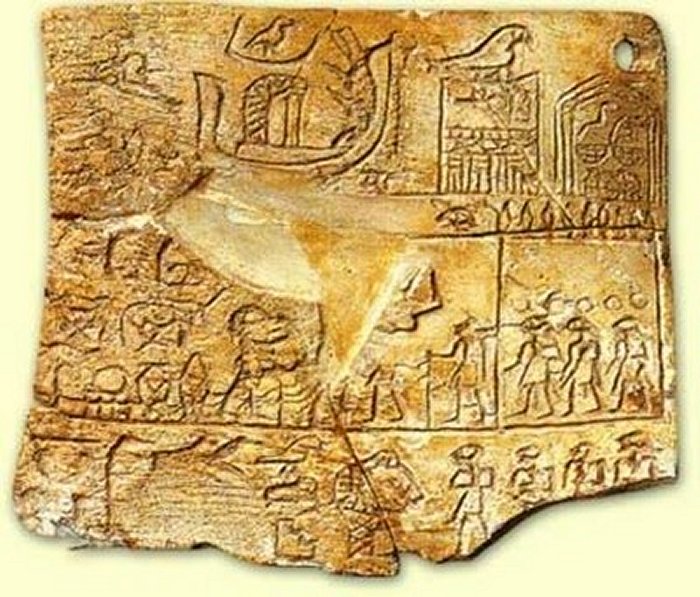Menes – Legendary First Monarch Probably Under Different Names Who Unified Egypt
A. Sutherland - AncientPages.com - The earliest rulers of the long-lasting civilization of Egypt were called "The followers of Horus." At the beginning of its long history, Egypt was united when an Upper Egyptian kingdom seized Lower Egypt in the north in the south.
The Upper Egyptian rulers called themselves "followers of Horus," and Horus became the tutelary deity of the unified country and its kings.
Left: Cartouche of Meni (Menes) from the Abydos King List in the temple of Seti I at Abydos. Right: Close-up view of Narmer on the Narmer Palette. Image credit: Wikipedia
According to legend and myth, in approximately 3100 BC, the king who made this unification possible was Menes. He was known by the ancient Egyptians as M'na (in Greek: Mên or Menes). It is assumed that he reigned from 30 to 60 years.
His name is similar to Minos in Greece, Manis in Phrygia, or Menu in India's history. Many modern scholars identified him with the archaic Egyptian kings, Horus Narmer of Naqada III (3200 to 3000 BC) and Horus Aha.
The Horus Name was the oldest part of the royal titular in ancient Egypt. It was a very important and powerful title with great symbolic meaning linking the king's earthly power with the divine power of the mighty celestial god Horus, the falcon.
Many researchers identify Narmer with the First Dynasty pharaoh Menes, who is also sometimes credited with the unification of Egypt, as the first pharaoh. This conclusion is based on the Narmer Palette, in which Narmer is shown as the unifier of Egypt. Image: Egyptian Museum, Cairo via Wikipedia
Priest and historian Manetho, who lived and worked during the Ptolemaic era in the early 3rd century BC, referred to him as 'Menes,' and Herodotus of Halicarnassus (c.480-c.429 BC) mentioned him as 'Min.'
According to tradition - not supported by the archeological record dated to the times of Menes – he was an important monarch always placed at the top of Egypt's dynastic lists, although there were no contemporary monuments or inscriptions referring to him.
Whether he was a legendary or real historical figure has not been determined yet.
Legendary Menes is credited with diverting the course of the Nile in Lower Egypt and founding a brand new administrative city located near the delta and the Nile Valley – 'Inbuhedj' (or 'White Walls').
This city, later known as Mennefer (Memphis), was one of the oldest and most important cities, situated 20 km (12 mi) south of Giza.
An ivory label found at Naqada shows Narmer's successor, Aha, and could imply that Aha may have been – Menes. Image via touregypt.net
At Memphis, he also founded the temple of Ptah, the divine Craftsman and Potter of the gods, identified by the Greeks as the blacksmith, Hephaestus (Vulcan).
This legendary king Menes who achieved all this, is not attested by archaeology. No object bearing his name or an image was found, but it is known that kings had several names.
Did Menes appear under a different name?
The Narmer palette we mentioned earlier could be proof that Narmer was Menes. The palette shows a King of Egypt wearing two crowns – of both Upper and Lower Egypt. The palette commemorates the victory, a significant historical event of the unification of the two lands in one. Also, an ivory label found at Naqada shows Narmer's successor, Aha, and could imply that Aha may have been – Menes.
Menes is, in fact, a mystery because he could also be Horus Aha or Narmer, as many researchers have suggested. Perhaps the figure of king Menes was based on the legendary victories of several kings, but what's most important is the first dynasty of Egyptian kings had begun.
Updated on June2, 2022
Written by – A. Sutherland AncientPages.com Staff Writer
Copyright © AncientPages.com All rights reserved. This material may not be published, broadcast, rewritten or redistributed in whole or part without the express written permission of AncientPages.com
Expand for referencesReferences:
W. M. Flinders Petrie, The Royal Tombs of the Earliest Dynasties
E. J. Sweeney, The Genesis of Israel and Egypt
More From Ancient Pages
-
 Giants Roamed The Earth Millions Of Years Ago
Ancient Mysteries | Sep 30, 2015
Giants Roamed The Earth Millions Of Years Ago
Ancient Mysteries | Sep 30, 2015 -
 Thousands Of Mysterious Ancient Skeletons Discovered Near Vreta Abbey In Sweden
Archaeology | Sep 5, 2020
Thousands Of Mysterious Ancient Skeletons Discovered Near Vreta Abbey In Sweden
Archaeology | Sep 5, 2020 -
 Tomb Of Christopher Columbus Finally Found But There Is One Problem With His Body
Archaeology | Apr 9, 2022
Tomb Of Christopher Columbus Finally Found But There Is One Problem With His Body
Archaeology | Apr 9, 2022 -
 Amazing Archaeological Discovery In A Secret Underground Structure In Transylvania Could Rewrite Ancient History
Featured Stories | Feb 13, 2024
Amazing Archaeological Discovery In A Secret Underground Structure In Transylvania Could Rewrite Ancient History
Featured Stories | Feb 13, 2024 -
 Unique Archaeological Finds Point To The Lost Indigenous Town Of Sarabay In Florida
Archaeology | Jun 20, 2022
Unique Archaeological Finds Point To The Lost Indigenous Town Of Sarabay In Florida
Archaeology | Jun 20, 2022 -
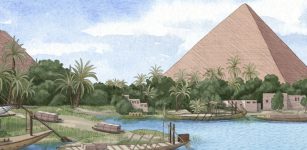 Evidence The Khufu Channel Aided The Construction Of The Giza Pyramids Found – Scientists Say
Archaeology | Aug 31, 2022
Evidence The Khufu Channel Aided The Construction Of The Giza Pyramids Found – Scientists Say
Archaeology | Aug 31, 2022 -
 Runic Inscription On The Viking-Age Galloway Hoard Deciphered
Archaeology | Feb 13, 2025
Runic Inscription On The Viking-Age Galloway Hoard Deciphered
Archaeology | Feb 13, 2025 -
 Egypt’s Oldest Tomb Oriented To Winter Solstice Discovered In Aswan
Archaeology | Nov 18, 2022
Egypt’s Oldest Tomb Oriented To Winter Solstice Discovered In Aswan
Archaeology | Nov 18, 2022 -
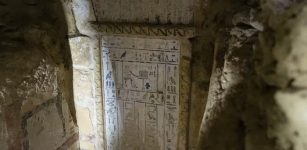 Archaeologists Have Discovered A Mummy Wrapped In Gold – Here’s What It Tells Us About Ancient Egyptian Beliefs
Featured Stories | Feb 7, 2023
Archaeologists Have Discovered A Mummy Wrapped In Gold – Here’s What It Tells Us About Ancient Egyptian Beliefs
Featured Stories | Feb 7, 2023 -
 Millennia-Old Sumerian Tripod Vase Dedicated To God Ningirsu, The Son OF Enlil
Archaeology | Oct 6, 2016
Millennia-Old Sumerian Tripod Vase Dedicated To God Ningirsu, The Son OF Enlil
Archaeology | Oct 6, 2016 -
 On This Day In History: SS City of Glasgow Leaves Liverpool And Is Never Seen Again – On March 1, 1854
News | Mar 1, 2017
On This Day In History: SS City of Glasgow Leaves Liverpool And Is Never Seen Again – On March 1, 1854
News | Mar 1, 2017 -
 Controversial Tunnel Plan Near Stonehenge Gets U.K. Government Approval – Shocked And Angry Opponents Will Challenge The Decision In High Court
News | Nov 13, 2020
Controversial Tunnel Plan Near Stonehenge Gets U.K. Government Approval – Shocked And Angry Opponents Will Challenge The Decision In High Court
News | Nov 13, 2020 -
 Strange Bodies And Skulls Of Ancient Unknown Mighty Warriors Found In Virginia
Featured Stories | Sep 10, 2024
Strange Bodies And Skulls Of Ancient Unknown Mighty Warriors Found In Virginia
Featured Stories | Sep 10, 2024 -
 America’s Mysterious Pedro Mountain Mummy And The Hidden Race Of Little People
Featured Stories | Jul 3, 2014
America’s Mysterious Pedro Mountain Mummy And The Hidden Race Of Little People
Featured Stories | Jul 3, 2014 -
 London’s Underground Rivers Were Deliberately Hidden
Featured Stories | Oct 8, 2018
London’s Underground Rivers Were Deliberately Hidden
Featured Stories | Oct 8, 2018 -
 On This Day In History: George Plantagenet Privately Executed At The Tower Of London – On Feb 18, 1478
News | Feb 18, 2017
On This Day In History: George Plantagenet Privately Executed At The Tower Of London – On Feb 18, 1478
News | Feb 18, 2017 -
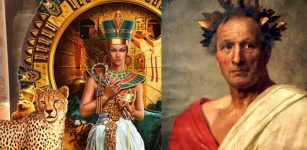 It’s Possible To Find Your Ancient Doppelganger – This Is What You Need To Do
Archaeology | Apr 26, 2017
It’s Possible To Find Your Ancient Doppelganger – This Is What You Need To Do
Archaeology | Apr 26, 2017 -
 Secrets Of The Famous Hellenistic-Era Kyrenia Shipwreck Revealed
Archaeology | Jun 28, 2024
Secrets Of The Famous Hellenistic-Era Kyrenia Shipwreck Revealed
Archaeology | Jun 28, 2024 -
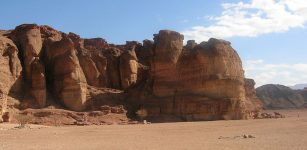 3,000 Years Ago Human Activity Destroyed Vegetation And Irreparably Damaged The Timna Valley Environment
Archaeology | Sep 23, 2022
3,000 Years Ago Human Activity Destroyed Vegetation And Irreparably Damaged The Timna Valley Environment
Archaeology | Sep 23, 2022 -
 Book Of Kells: Illuminated Medieval Manuscript From Monastery On Iona, Scotland
Artifacts | Feb 8, 2018
Book Of Kells: Illuminated Medieval Manuscript From Monastery On Iona, Scotland
Artifacts | Feb 8, 2018



